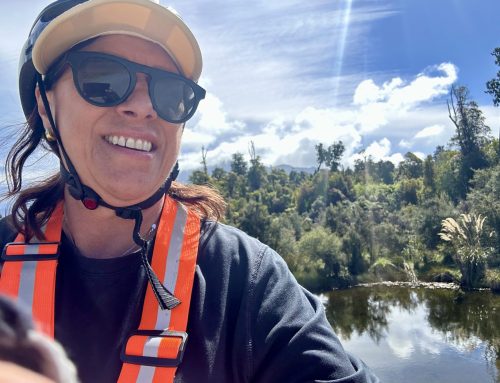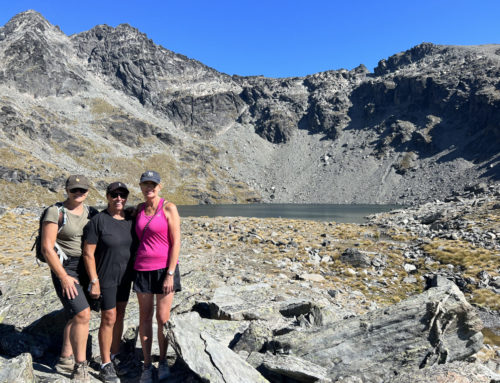Our journey cycling the Central Otago Rail Trail began at Dunedin Railway Station where we boarded the Taieri Gorge Railway. The grandiose railway station built in 1906 was designed by architect, George Troup. So rich are its embellishments it earned him the nickname, ‘Gingerbread George.’

Dunedin’s embellished railway station was built in 1906.
At the time, Dunedin was the largest commercial centre in New Zealand, so a railway station of this magnitude seemed fitting. It was seen as the jewel in the crown of railway stations and is still an impressive building today.
As we departed from the station in the yellow Taieri Gorge train, we enjoyed an informative commentary from a good Southern man, rolling his r’s. We followed the Taieri River going over the impressive Wingatui Viaduct, through the Taieri Plains and Salisbury Tunnel until we reached the end of the line at Pukerangi. From there we were transported by road to Middlemarch, the beginning of the rail trail.

The Taieri Gorge Railway, making its way to the end of the line at Pukerangi.
Central Otago was founded on gold, but after the gold rush in the 1860s some miners stayed on. They started businesses, farms and orchards, which necessitated a railroad to get the goods to Dunedin.
Construction began in 1879 taking 28 years to complete. To ensure it was the primary source of transportation for goods, the Government protected the railway from the competition by placing restrictions on the distance goods could travel by road.
However, by 1983 the restrictions ended, and the closing of the railway was inevitable. Following the completion of the Clyde Dam in 1990 the rail link was closed. Ten years later, the Central Otago Rail Trail opened in 2000.

The Central Otago Railway was used to transport material for the construction of the Clutha Dam.
Having arrived in Middlemarch, we picked up bikes at Trail Journey’s depot and headed off. The surprising thing about the rail trail is there are no hills as trains can only go up gradual inclines. The cycle path is broader than a train carriage, allowing for plenty of room for cyclists coming the other way. The 150 kilometres trail takes you through beautiful Central Otago landscapes including farmland, character-rich towns that are a reminder of the glory days of gold mining, deserted railway track and dark tunnels.

The heritage has been well-preserved with many of the old railway stations intact, as well as viaducts, stonework and bridges. Huts along the way have also been restored and have information about the railway. One fascinating but tragic snippet we learnt was the train disaster in 1893. A train approached a bend travelling 120 kilometres an hour, twice the recommended speed and all seven carriages de-railed, killing 21 people.

Middlemarch’s historic railway station and rail yard.
After cycling for the afternoon, we arrived at Hyde for our first night. We were welcomed at Hyde Lodge by our host, later enjoying a delicious salmon entrée and lamb shanks in our cottage. Well satisfied we crawled into bed in anticipation of another great day the next day.
Our second day entailed biking from Hyde to Ranfurly. The highlights were the 32-metre high Price Creek Viaduct and the Price’s Creek tunnel.
We arrived in Ranfurly with plenty of time to visit nearby Naseby, famous for curling. With two outdoor rings for the winter and an all-year inside ring, it’s a popular sport. We tried our hand at curling and disappointedly, found it very challenging.

Curling in Nasby – it’s harder than it looks.
The following day on the stretch from Ranfurly to Oturehuawe reached the highest point on the trail, 618 metres above sea level. On route, we stopped for coffee at Wedderburn before continued on our way to Oturehua for lunch. Finally, we arrived at Inverlair Lodge for the night and later enjoyed a game of pool and dinner with the locals at a nearby pub.

A fun night of pool at the local pub in Inverlair.
Just two kilometres out of Oturehua is the Hayes Engineering Works. It was here Ernest Hayes invented the world-famous wire strainer and the cattle stop. With 10 children, his wife Hannah left their 12-year old daughter to look after the younger siblings while she rode hundreds of miles throughout Central Otago selling their wares. The workshop is a sight to behold, with everything still intact.

This is typical of the cycling trail – wide, mostly flat tracks with a fine gravel surface.
Leaving the warmth of Inverlair Lodge the next morning we were pleased we had our thermals, hat and gloves as the temperature had dropped significantly overnight. We cycled through the Ida Valley and Poolburn Gorge Tunnels, enjoying the long, flat wide valley with grazing sheep.
Arriving in the pretty township of Omakau, our accommodation was just two kilometres away in the small historic town of Ophir. We stayed at Blacks Hotel, a warm and friendly pub, with great ambience and even better food.
Now on the last leg of our journey, we headed to Clyde. The route took us through Alexandra where poplar and willow leaves were turning, creating a stunning display of autumn hues.
In Alexandra, we opted to go on a Clutha River Cruise, despite the chilling wind. Our driver and guide gave us a fascinating commentary on the gold rush in the 1860s, pointing out many of the gold miner’s homes on the banks of the river. Built into the schist rock, they created caves like a shelter with fireplaces, but I have no idea how they managed to keep warm in the bitterly cold winters.
Arriving at our final destination, we enjoyed the historic settlement of Clyde. The Dunstan Hotel and Olivers Lodge and Stables are stunning examples of late 1880s architecture. At the far end of the town is the Clyde Dam, New Zealand’s third-largest hydropower station.

Clyde is a beautiful historic town, with many of the original old buildings having been restored.
From Clyde, it was a little over an hour to travel to Queenstown by road.
Q & A
Who should I book with to cycle the Central Otago Rail Trail? Several companies offer this service, but we choose Trail Journeys. They organised every aspect of our trip from your train ticket, transfers, luggage transfers to your next destination, accommodation, activities like curling in Naseby and the Clutha River Cruise and of course your bike. They were excellent, and our five-day rail trail experience was seamless.
Which is the best way to ride the Central Otago Rail Trail? We started in Dunedin and finished in Clyde. However, you can cycle the other direction.
What’s the best time of year to cycle the rail trail? Summer, although January can be very hot.
Should I get an e-bike? I opted for an e-bike, but I barely used the extra power. However, there can be strong headwinds and battling into them would be much more manageable with an e-bike.
For more great New Zealand destination to explore, click on the links below:
Exploring NZ post-Covid-19 – Taiarao Head, Dunedin
Exploring NZ post-Covid-19 – Catlins
Exploring NZ post-Covid-19 – Abel Tasman Coastal Track
Exploring NZ post-Covid-19 – Dusky Sound






Leave A Comment